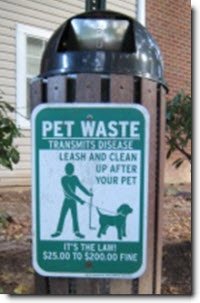Sources and Solutions: In and Around the Home

Our homes - through appliances, yards, driveways and even pets - contribute to nutrient pollution. Roadside storm drains often lead directly to local streams and rivers, so anything that flows into them makes it to local waterways without treatment. Residential areas can be a significant source of excess nitrogen and phosphorus pollution from fertilizers. Over-fertilizing and overwatering a yard is a common practice among homeowners and landscaping services and can lead to fertilizer being washed away more easily. Additionally, pet waste contributes nitrogen, phosphorus, parasites and bacteria to water bodies when it is not disposed of properly. Pet waste that is not properly disposed of can lead to conditions in local water bodies that are unsafe for human recreation.
There are also sources of nutrient pollution inside our homes. Many laundry, dish and car washing soaps contain a form of phosphorus called phosphates, which are carried from our homes into the water system through our drains. We also add excess nitrogen to the atmosphere through the use of electricity in our homes. Most of our electricity comes from the burning of fossil fuels, which release pollutants into the environment.
Read about what you can do in and around your home to reduce nutrient pollution.

